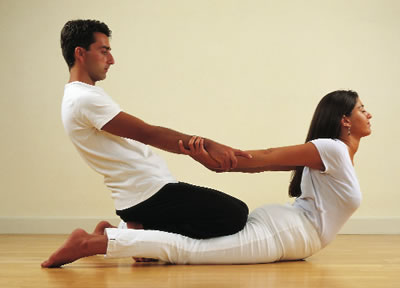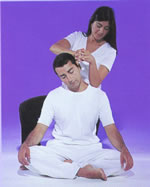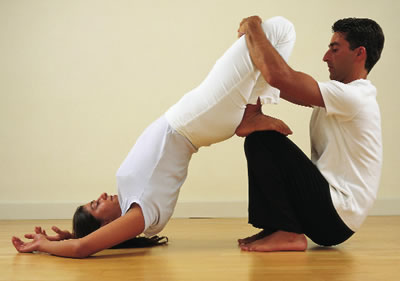Positive Health Online
Your Country

Thai Yoga Massage - an Ancient Healing Art
listed in thai yoga massage and bodywork, originally published in issue 102 - August 2004
As Thai massage has grown in popularity outside as well as Inside Thailand, it has acquired a host of names – 'Traditional Thai massage', 'Thai Yoga massage', 'Nuad Thai' and others. Whatever the name, they all refer to the same healing art that has been practised in Thailand for thousands of years.
A Brief History
Thai Yoga massage can look back at a long history of therapeutic healing. If one traces the evolution of the techniques of healing massage practised in Thailand, one discovers the astonishing fact that the earliest roots of Thai massage lie not in Thailand, but in India. The legendary founder of the art is believed to have been a doctor from Northern India known as Jivaka Kumar Bhaccha, who was a contemporary of the Buddha and personal physician to the Magadha King Bimbisara, over 2500 years ago.
It is believed that Thai Yoga massage came to Thailand along with Buddhism as early as the 3rd or 2nd century BC. The exact origins remain obscure due to the fact that for centuries, Thai medical knowledge was mostly passed down orally from teacher to pupil rather than written down. Another reason for this obscurity is that whatever medical scriptures did exist, were destroyed by Burmese invaders in 1767 when they attacked the old capital of Thailand, Ayutthaya. Only some remnants survived and are carved on the walls of a famous temple in Bangkok, Wat Po.

The Cobra
Thai Massage Today
In recent years there has been a revival of Thai Yoga massage in Thailand. Before this, the increasing popularity of orthodox Western medicine meant that authentic Thai forms of healing and massage were being replaced – although by no means lost.
An interest in alternative forms of medicine, which developed in the West during the 1980s, brought many Westerners to Thailand in search of traditional and indigenous forms of healing and treatment.
The people and government of Thailand now recognize that Thai Yoga massage is far superior to conventional medicine in the treatment and prevention of many common ailments. For example, it can often be more effective than physiotherapy or medication in helping people to recover after a stroke, by returning mobility and feeling to their limbs.
How Does it Work?
The theoretical foundation of Thai Yoga massage is based on the belief that there is a life force that circulates around pathways in the body. Indian Yoga philosophy calls this life force 'Prana'. It is said to be absorbed with the air that we breathe and the food that we eat. In Thai Yoga massage, these pathways make up an energy system. This system is said to be made up of 72,000 invisible energy lines. If there is a blockage in any line, preventing free flow of Prana, it can lead to aches, pains and disease on a physical, emotional and spiritual level.Thai Yoga massage concentrates on ten important lines called the 'Ten Sen'. A thorough Thai massage treatment covers all ten lines. These ten main energy lines are sufficient to conduct practical treatment for the whole body and its internal organs. This will ensure that blocked energy is released, restoring health, harmony and balance. When Prana flows freely, our general wellbeing is greatly improved.

Neck-Elbow. The therapist uses her elbow to apply
pressure to the shoulder area while stretching the neck
Thai massage differs from Swedish massage, which is the most widespread technique of massage in the West. The kneading of muscles, which dominates in Swedish massage, is absent from Thai massage – energy points are pressed or general pressure is used instead. There is a lot of stretching involved and many exercises might well be described as applied Yoga.
Physiotherapy and Chiropractic in the West are closer to Thai massage than is Swedish massage, but these techniques ignore manipulating acupressure points and the energy flow of the body and, unlike Thai massage, their theoretical foundations are based on the anatomical structure of the body.

Kidney Stretch. This exercise benefits the kidneys in two ways: The pressure on the feet
acts on points that stimulate the kidneys and the final position stretches the kidney area
Who Can it Help?
Thai Yoga massage is an excellent way to keep the body in tune; receiving regular treatments can be as beneficial for people with no particular problems as it is for people suffering from common ailments or even with more serious conditions.
Some of the conditions that Thai massage has proven extremely effective in treating are ailments such as frozen shoulder, asthma, back pain, neck and shoulder pain, multiple sclerosis, chronic fatigue, insomnia, menstrual problems and many more. I have had remarkable results working with multiple sclerosis; many MS patients have reported relief from various nasty bodily effects of the disease as well as it helping to maintain a better capacity for walking. There is also almost always a marked improvement in the feeling in the limbs which have often lost sensation.
The Yoga positions and stretching makes Thai Yoga massage ideal for sports people, Yoga practitioners and dancers, whilst the energy line workout is especially beneficial during pregnancy and after giving birth. Due to some of the stretches used, some people have the impression that they must be very flexible to receive Thai massage. This is definitely not the case; Thai Yoga massage is beneficial for people of all ages and flexibility. The session is designed to suit the needs of the recipient. There are such a wide variety of techniques and stretches and no-one is taken beyond his or her own personal limit. If someone is less flexible or unwell, more emphasis would be placed on working the energy lines with acupressure rather than stretching the body.
What Are the Benefits?
There are many benefits in receiving a Thai massage. It usually takes four or five days for the balancing of the energy systems of the body to be complete. This means that people often continue to experience the beneficial effects for some time after the massage and not just during the treatment. Some people feel immediately energized as the new energy flows into the body. Other people can feel very tired straight after the treatment as the negative and old energy leaves the body. Whatever the first reaction, after a few days the energy will be re-balanced and with it a sense of harmony and well being will be experienced.
Other benefits include greater flexibility in the joints, enhanced blood circulation, better alignment of the body, improved posture and better functioning of the internal organs. Thai Yoga massage usually leaves the recipient with an invaluable feeling of relaxation and tranquility.
The Spirit of Thai Yoga Massage
Another very important aspect of Thai Yoga massage is its spiritual nature. Until recently it was always given in a temple and seen as an extension of Buddhist practice – particularly meditation. There are two forms of meditation in Thai Yoga massage. Firstly, when giving a massage, the practitioner should feel a sense of awareness and of being present in every moment. Secondly, the giver practices 'metta' or 'loving kindness' meditation. A beautiful description of Thai Yoga massage is that it is said to be "The physical application of loving kindness". A session of Thai Yoga massage takes place on a mat on the floor and is applied through loose comfortable clothing. The treatment is both relaxing and energizing and usually lasts between one-and-a-half and two hours. It is a really thorough massage, the whole body is included in the treatment, from the tips of the toes, to the tips of the fingers, to the top of the head – Thai massage leaves no stone unturned! The therapist uses hands, feet and elbows to apply pressure to important points along the energy lines in combination with Yoga-based stretches. The pressure is always applied in a flowing and rhythmical way, which feels wonderful for the recipient as well as making it a relaxing and enjoyable experience for the giver.
Thai Yoga massage is as much of a gift for the practitioner as the recipient. A massage given in a meditative mood with awareness and care, will not only feel relaxing and healing to receive, but should also leave the giver feeling peaceful and calm.
Bibliography
Balaskas, Kira. Thai Yoga Massage UK. Thorsons. ISBN 0-00-713232-8. 2002.
Further Information
The School of Thai Yoga Massage was established by Kira in 1993. It was one of the first schools in this country offering students an opportunity to learn this distinct massage form. Both beginners and advanced courses are offered and all courses are accredited by the International Guild of Professional Practitioners (IGPP). For a prospectus or further information on courses or treatments the School may be contacted on Tel: 0845 0900 211; info@thaiYogamassage.co.uk www.thaiYogamassage.co.uk
For information on treatments you can also visit The Massage Company website www.themassageco.com
Comments:
-
No Article Comments available